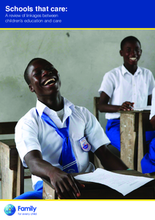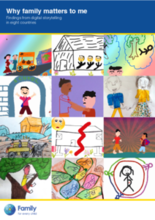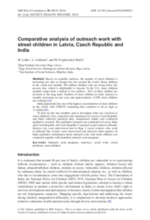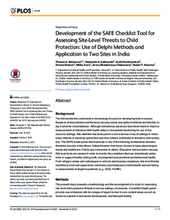childrens_living_arrangement
children_living_without_bio
Displaying 341 - 350 of 427
This is an explorative study undertaken in central and south part of the Mumbai with the objective of investigating socio-economic, demographic and cultural characteristics of street adolescents in Mumbai.
This report presents the key findings of a scoping study on the links between education and children’s care. The study involved a literature review in English, French and Spanish; key informant interviews; and consultations with 170 children, carers, teachers and other stakeholders in Guyana, India, Russia and Rwanda.
This report examines what family means to children and adults in the following countries: Brazil, India, Guyana, South Africa, Egypt, Mexico, Russia, Kenya. The storytellers use evidence from 59 short films made using digital storytelling technique.
This study compared the generalized anxiety, conduct and peer relationship problems and their associated risk factors among children orphaned by HIV/ AIDS and those due to other reasons in the Indian city of Hyderabad.
This study notes that there are currently 700 million people below the poverty line. According to this study, around 40 percent are considered vulnerable children. It further states that according to UNICEF India has approximately 11 million children living on the streets. It is one of the highest concentration of the street children in the world. To investigate the status of street children, this study investigated outreach work in Latvia, Czech Republic and India.
Meant to highlight the maxim that every child deserves the best that we all have to give; this book provides a review of the progress made since The UN Convention on the Rights of the Child. It contains reports from 21 countries on the status of the rights of the child. The countries are: Australia, Canada, Croatia, Denmark, France, Germany, Greece, India, Iran, Japan, Portugal, Romania, Scotland, Serbia, Solomon Islands, Spain, the Netherlands, the UK, the USA, Uzbekistan and Venezuela. There are no reports from Africa.
A press release from the Ministry of Women and Child Development, Government of India recapped a series of new initiatives by the Ministry during 2015. The achievements relevant to children’s care are briefly described below and include the launch of the flagship programme Beti Bachao Beto Padhao for protection of the girl child; several initiatives to track, restore, and rehabilitate missing children; and adoption reforms and a new foster care system.
The Madurai bench of the Madras high court on Friday ordered a judicial probe into the alleged human rights violations at an unregistered orphanage in Trichy district, India.
L’Etat d’Andra Pradesh est l’une des régions d’Inde qui fait face à un trafic d’enfants des plus importants. Pour renforcer les capacités des Comites de protection de l'enfance, Tdh a mis en place des procédures afin d’affronter les différentes situations, des formations à l’intention du personnel et une assistance téléphonique notamment.
This study in India sought to develop the SAFE Checklist in order to assess site-level threats to child protection among children and families living in settings of adversity. The tool was field tested in two diverse sites in India (a construction site and a railway station) and the results demonstrated that the SAFE Checklist is a sensitive tool that captured the differences between the two sites from the standpoint of core child protection issues.





